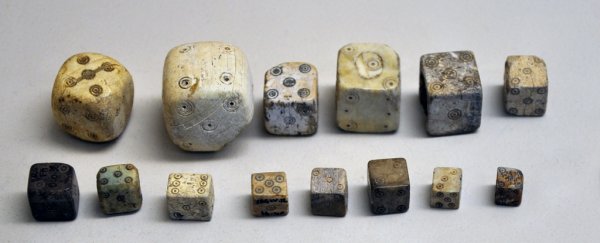The game dice we use today are as fair as we can design them - but that wasn't always the case. And now researchers have analysed the history of dice to work out when things changed, and why people didn't care about these probabilities until a certain turning point in civilisation.
Researchers from UC Davis and the American Museum of Natural History have examined 110 cube-shaped dice dating back to the Roman era and found that their design didn't become "fair" until the Renaissance, when scientific thinking started to come to the fore.
The lofty new ideas being developed during the Renaissance trickled down, explained lead author of the study, Jelmer Eerkens of UC Davis.
"People like Galileo and Blaise Pascal were developing ideas about chance and probability, and we know from written records in some cases they were actually consulting with gamblers," he said.
"We think users of dice also adopted new ideas about fairness, and chance or probability in games."
There are two main components that make dice work. The multi-sided shape (for the purpose of this study, the researchers focused on six-sided cubes); and the numbers inscribed on the sides.
Roman-era dice, the researchers found, were a mess when it came to shape. They were made from a variety of materials, such as metal, bone and clay, and no two were shaped entirely alike. Many were visibly lumpy and lopsided, with the 1 and 6 on opposite sides that were more likely to roll up.
It's difficult to know why this was the case, but the researchers suggested that Roman-era dice-rollers either didn't care, or believed providence was determining the outcome of the roll - so the shape of the dice didn't matter very much.
Dice aren't easy to find. They don't usually appear in archaeological sites and in graves, but are found on ancient garbage heaps or cemeteries, or even just by themselves.
As a result, they are pretty tricky to date, which is why the research team only had 110 dice to examine - they looked at hundreds of dice in museums, but only selected the ones that could be accurately appointed a time period.
Eerkens and his co-author, Alex de Voogt of the American Museum of Natural History, have been studying dice design for several years.
Their previous finding revealed that there have been two preferred pip configurations of the 15 possible configurations for a six-sided die throughout the millennia.
In the Dark Ages, between 400CE and 1100CE, dice seem to have grown rare, with relatively few found. They reemerged in the Middle Ages, and at that point were a little more regular in shape.
But the pips were in what is known as the "primes" configuration, popular in Ancient Egypt and Mesopotamia. In this configuration, the pips on opposite sides of a die add up to prime numbers. So 1 is opposite 2, 3 is opposite 4, and 5 is opposite 6.
In the 15th century - around 1450 - dice started to change to what the researchers call the "sevens" configuration. In this configuration, the pips on opposite sides add up to the number 7; so 1 is opposite 6, 2 is opposite 5, and 3 is opposite 4.
This is the configuration still in standard use today.
It may not actually be more fair, but may have seemed so, by separating and "balancing" the larger and smaller numbers on the cube. In turn, this could have led to standardisation.
"Standardising the attributes of a die, like symmetry and the arrangement of numbers, may have been one method to decrease the likelihood that an unscrupulous player had manipulated the dice to change the odds of a particular roll," Eerkens said.
The new research has been published in the journal Acta Archaeologica.
